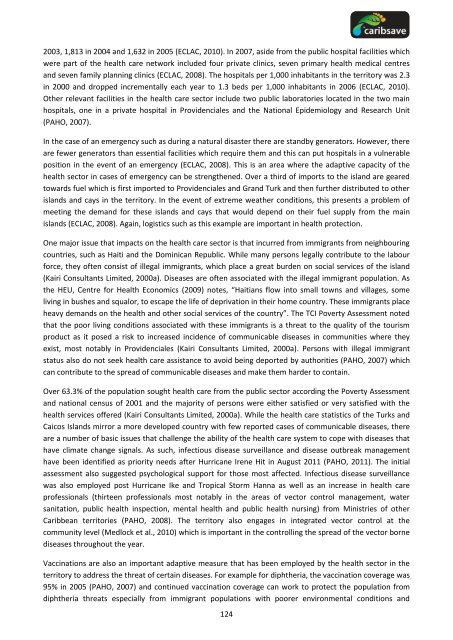You also want an ePaper? Increase the reach of your titles
YUMPU automatically turns print PDFs into web optimized ePapers that Google loves.
2003, 1,813 in 2004 <strong>and</strong> 1,632 in 2005 (ECLAC, 2010). In 2007, aside from the public hospital facilities which<br />
were part of the health care network included four private clinics, seven primary health medical centres<br />
<strong>and</strong> seven family planning clinics (ECLAC, 2008). The hospitals per 1,000 inhabitants in the territory was 2.3<br />
in 2000 <strong>and</strong> dropped incrementally each year to 1.3 beds per 1,000 inhabitants in 2006 (ECLAC, 2010).<br />
Other relevant facilities in the health care sector include two public laboratories located in the two main<br />
hospitals, one in a private hospital in Providenciales <strong>and</strong> the National Epidemiology <strong>and</strong> Research Unit<br />
(PAHO, 2007).<br />
In the case of an emergency such as during a natural disaster there are st<strong>and</strong>by generators. However, there<br />
are fewer generators than essential facilities which require them <strong>and</strong> this can put hospitals in a vulnerable<br />
position in the event of an emergency (ECLAC, 2008). This is an area where the adaptive capacity of the<br />
health sector in cases of emergency can be strengthened. Over a third of imports to the isl<strong>and</strong> are geared<br />
towards fuel which is first imported to Providenciales <strong>and</strong> Gr<strong>and</strong> Turk <strong>and</strong> then further distributed to other<br />
isl<strong>and</strong>s <strong>and</strong> cays in the territory. In the event of extreme weather conditions, this presents a problem of<br />
meeting the dem<strong>and</strong> for these isl<strong>and</strong>s <strong>and</strong> cays that would depend on their fuel supply from the main<br />
isl<strong>and</strong>s (ECLAC, 2008). Again, logistics such as this example are important in health protection.<br />
One major issue that impacts on the health care sector is that incurred from immigrants from neighbouring<br />
countries, such as Haiti <strong>and</strong> the Dominican Republic. While many persons legally contribute to the labour<br />
force, they often consist of illegal immigrants, which place a great burden on social services of the isl<strong>and</strong><br />
(Kairi Consultants Limited, 2000a). Diseases are often associated with the illegal immigrant population. As<br />
the HEU, Centre for Health Economics (2009) notes, “Haitians flow into small towns <strong>and</strong> villages, some<br />
living in bushes <strong>and</strong> squalor, to escape the life of deprivation in their home country. These immigrants place<br />
heavy dem<strong>and</strong>s on the health <strong>and</strong> other social services of the country”. The TCI Poverty Assessment noted<br />
that the poor living conditions associated with these immigrants is a threat to the quality of the tourism<br />
product as it posed a risk to increased incidence of communicable diseases in communities where they<br />
exist, most notably in Providenciales (Kairi Consultants Limited, 2000a). Persons with illegal immigrant<br />
status also do not seek health care assistance to avoid being deported by authorities (PAHO, 2007) which<br />
can contribute to the spread of communicable diseases <strong>and</strong> make them harder to contain.<br />
Over 63.3% of the population sought health care from the public sector according the Poverty Assessment<br />
<strong>and</strong> national census of 2001 <strong>and</strong> the majority of persons were either satisfied or very satisfied with the<br />
health services offered (Kairi Consultants Limited, 2000a). While the health care statistics of the <strong>Turks</strong> <strong>and</strong><br />
<strong>Caicos</strong> Isl<strong>and</strong>s mirror a more developed country with few reported cases of communicable diseases, there<br />
are a number of basic issues that challenge the ability of the health care system to cope with diseases that<br />
have climate change signals. As such, infectious disease surveillance <strong>and</strong> disease outbreak management<br />
have been identified as priority needs after Hurricane Irene Hit in August 2011 (PAHO, 2011). The initial<br />
assessment also suggested psychological support for those most affected. Infectious disease surveillance<br />
was also employed post Hurricane Ike <strong>and</strong> Tropical Storm Hanna as well as an increase in health care<br />
professionals (thirteen professionals most notably in the areas of vector control management, water<br />
sanitation, public health inspection, mental health <strong>and</strong> public health nursing) from Ministries of other<br />
Caribbean territories (PAHO, 2008). The territory also engages in integrated vector control at the<br />
community level (Medlock et al., 2010) which is important in the controlling the spread of the vector borne<br />
diseases throughout the year.<br />
Vaccinations are also an important adaptive measure that has been employed by the health sector in the<br />
territory to address the threat of certain diseases. For example for diphtheria, the vaccination coverage was<br />
95% in 2005 (PAHO, 2007) <strong>and</strong> continued vaccination coverage can work to protect the population from<br />
diphtheria threats especially from immigrant populations with poorer environmental conditions <strong>and</strong><br />
124





